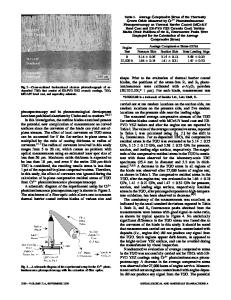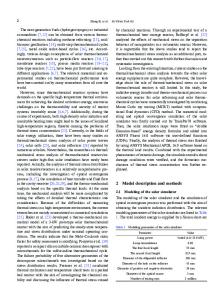Thermal stress analysis for coated fibers
- PDF / 750,824 Bytes
- 8 Pages / 612 x 828 pts Page_size
- 117 Downloads / 360 Views
Thermal stresses induced during cooling from temperatures used for coating deposition were calculated for various fiber-coating systems. Systems under study include several types of carbon, alumina, and zirconia fibers. Coatings considered were TiB 2 , S13N4, and SiC. Typical calculated stresses were on the order of 0 to 2 GPa. The results were used to analyze the effects of variable physical parameters such as coating thickness and crystallographic orientation on the stress levels. Each fiber-coating system was then compared using a nominal coating thickness of 5 //.m in order to rank the various fiber-coating combinations. Among the results obtained, it was shown that orientation of deposited coatings usually leads to higher tensile stresses.
I. INTRODUCTION Several technologies exist where monofilaments or fiber tows are coated.1"9 These include (i) production of a new structural fiber by deposition of, for example, SiC onto a carbon fiber substrate, (ii) alteration of the interfacial properties of fibers subsequently incorporated into composites, and (iii) enhancement of the physical, mechanical, or chemical properties of the fiber, e.g., improved resistance to oxidation. The amount of coating desired varies from less than 0.1 /xm to nearly 100 /urn, and a number of coating techniques, including chemical vapor deposition (CVD), may be used. The advantages derived from the coating, however, may be diminished by the presence of two independent types of stresses within both fiber and coating. One type of stress is produced by bending of coated fibers. These stresses are directed primarily along the length of the fiber (axial stresses) and may lead to segmentation of the fiber and/or coating. The other is due to cooling from the high temperatures at which deposition commonly takes place. These are the thermal stresses, which may be further divided into two categories. Mismatch thermal stresses occur as a result of differences in the thermal expansion coefficients of the fiber and coating. Anisotropic thermal stresses occur from anisotropy that may be present in both fiber and coating. In this paper, we shall always mean by thermal stresses the sum of the mismatch and anisotropic stresses. It should be noted that in accord with the right circular cylindrical geometry of the fiber-coating system, stresses are divided into axial, radial, and tangential components (Fig. 1). In addition to segmentation of fiber and/or coating, thermal stresses may also lead to circumferential and radial cracking. Such damage to the fiber-coating system, it should be remarked, is the result of tensile (positive) stresses. A thorough discussion of compressive stresses and accompanying damage modes is beyond the scope of J. Mater. Res., Vol. 9, No. 3, Mar 1994
http://journals.cambridge.org
Downloaded: 15 Mar 2015
this paper. A more complete treatment of stresses and system failure in fiber-coating systems can be found in the recent paper by Hsueh et al.w There are several variable parameters which influence stresses, particularly therm
Data Loading...











